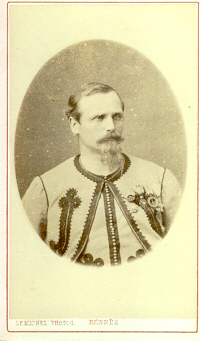Athanase-Charles-Marie Charette de la Contrie
 From Wikipedia the free encyclopedia
From Wikipedia the free encyclopedia
Athanase-Charles-Marie Charette de la Contrie | |
|---|---|
 Athanase-Charles-Marie Charette de La Contrie in 1871 | |
| Born | 3 September 1832 Nantes, France |
| Died | 9 October 1911 (aged 79) Saint-Père-Marc-en-Poulet, France |
| Allegiance | |
| Service | Infantry |
| Years of service | 1846-1871 |
| Rank | Général de brigade |
| Commands | Papal Zouaves Légion des volontaires de l'Ouest |
| Battles / wars | Unification of Italy |
| Awards | Légion d'honneur Cross of Metana |
| Other work | Elected deputy for Bouches-du-Rhône (1871 : refused to sit) |
Athanase Charles Marie de Charette, 2nd Baron de La Contrie (18 September 1832 in Nantes - 9 October 1911 in Saint-Père-Marc-en-Poulet), was a 19th century French général who distinguished himself in the defense of the Papal States and subsequently during the Franco-German war of 1870. He was a grandson of Charles Ferdinand, Duke of Berry, the third child and younger son of Charles X, and Amy Brown, the Duke’s English mistress.
Early life
[edit]Athanase Charles Marie Charette de La Contrie was born on 3 September 1832, in Nantes, France.[1] His great-grandfather was Charles X, the penultimate king of France,[2] and his great-uncle, General de Charette, was shot in Nantes on 29 March 1795, during the War in the Vendée.[1] His mother, Louise, Countess de Vierzon, was the daughter of the Duke of Berry and Amy Brown.[1] As the Duchesse de Berry was at that time in hiding at Nantes, and Charette's father was being sought by the police, the child's birth was concealed; he was secretly taken from Nantes on 17 September and was registered in the commune of Sainte-Reine as born on 18 September.[1]
Unwilling, because of his Legitimist antecedents, to serve in France under Louis Philippe, young Charette, in 1846, entered the Military Academy of Turin; he left in 1848 to avoid serving Piedmont-Sardinia, the revolutionary policy of that kingdom being evident to him.[1]
Military career
[edit]In 1852, the Duke of Modena, the brother-in-law of Henri, Count of Chambord, appointed Charette sub-lieutenant in an Austrian regiment stationed in the duchy.[1] Duke Francis V was not only ruler of Modena but was also an Austrian archduke and the Jacobite successor to the thrones of England, Scotland and Ireland. Duke Francis was a most exemplary ruler who, with his own hands, tended to and served the victims of cholera that broke out in his duchy when the Piedmontese revolutionary army invaded. The Piedmontese annexed and incorporated Modena into the new, anti-Catholic Italy.

Charette was thereby, compelled to relinquish regimental service as, once again, he did not wish to serve in a revolutionary army.
In May 1860, when two of his brothers, like him eager to fight the Italian revolutionaries, offered their services to the King of Naples, he went to Rome and placed himself at the service of Pope Pius IX, who had commissioned Lamoricière to organize an army for the defence of the Papal States. Charette was appointed captain of the first company of the Franco-Belgian Volunteers, known after 1861 as the Papal Zouaves, and was wounded at the Battle of Castelfidardo (September 1860).[1]
After the capture of Rome by the Kingdom of Italy, Charette negotiated with Gambetta for the employment of the French Zouaves in the service of France in the Franco-Prussian War; he was permitted to organize them as "Volunteers of the West". Wounded at Loigny, Charette was made prisoner; but he escaped, and on 14 January 1871, the Provisional Government of France made him a general. He was elected to the National Assembly by the department of Bouches-du-Rhône but resigned without taking his seat. Thiers proposed his entering the French army with his Zouaves, but Charette declared his intention of remaining at the Pope's disposal. On 15 August 1871, his Zouaves were mustered out of the French army. Retiring into private life, Charette passed his last thirty years serving the cause of religion and hoping for the restoration of the monarchy.[1]
Personal life
[edit]In Italy, Charette met his future (second) wife Antoinette Van Leer Polk in the Gilded Age. She was an American Southern belle, who was the great-niece of the 11th President of the United States James K. Polk and the "Mad" General Anthony Wayne of the American Revolutionary War. She was also a direct descendant of Samuel Van Leer, a patriarch of a wealthy family in Pennsylvania noted in the anti-slavery cause.[3][4]
Charette was the father of two children with his first wife and of two other children with the second. His direct descendant Susan Charette de la Contrie would marry General Ronald R. Van Stockum.[5]
Death
[edit]He died on 9 October 1911.[1]
References
[edit]- ^ a b c d e f g h i
 One or more of the preceding sentences incorporates text from a publication now in the public domain: Goyau, Pierre-Louis-Théophile-Georges (1913). "Baron Athanase-Charles-Marie Charette de la Contrie". In Herbermann, Charles (ed.). Catholic Encyclopedia. Vol. 16. New York: Robert Appleton Company.
One or more of the preceding sentences incorporates text from a publication now in the public domain: Goyau, Pierre-Louis-Théophile-Georges (1913). "Baron Athanase-Charles-Marie Charette de la Contrie". In Herbermann, Charles (ed.). Catholic Encyclopedia. Vol. 16. New York: Robert Appleton Company. - ^ MacGregor, Mary. The Story of France. London: Thomas Nelson and Sons. p. 464.
- ^ "Statement of Historical Significance" (TXT). USGenWebArchives. Retrieved 26 February 2024.
- ^ Smith Futhey, J. (2007). "History of Chester County, Pennsylvania, Biographies". History of Chester County, Pennsylvania, Biographies. pp. 687–688. ISBN 9780788443879.
- ^ "Charette Affiliate Family".